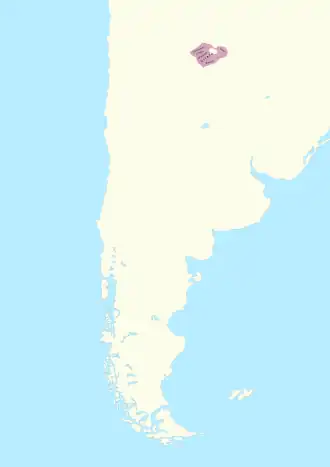Vilela language
| Vilela | |
|---|---|
| Uakambalelté | |
| Waqha | |
| Native to | Argentina |
| Region | eastern Chaco |
| Ethnicity | Vilela (Waqha-umbaꞵelte) |
Native speakers | 2 semispeakers (2007)[1] |
Lule–Vilela
| |
| Dialects |
|
| Language codes | |
| ISO 639-3 | vil |
| Glottolog | vile1241 |
| ELP | Vilela |
 Map of the Vilela language | |
 Vilela is classified as Extinct by the UNESCO Atlas of the World's Languages in Danger | |
Vilela (Uakambalelté, Atalalá, Chulupí~Chunupí)[2] is a moribund language last spoken in the Resistencia area of Argentina and in the eastern Chaco near the Paraguayan border. Dialects were Ocol, Chinipi, Sinipi; only Ocol survives. The people call themselves Waqha-umbaβelte 'Waqha speakers'. There were 2 semispeakers as of 2007.
The last Vilela people were absorbed into the surrounding Toba people and Spanish-speaking townsfolk.
Dialects
Loukotka (1968) lists the following varieties of Vilela.[3]
- Chunupi - formerly spoken on the confluence of the San Francisco River and Bermejo River in the vicinity of La Encrucijada, Valtolema, Ortega, Esquina Grande and Laguna Colma.
- Pasain - formerly spoken in the vicinity of Macapillo, Argentine Chaco.
- Ocole - formerly spoken between Lacangayá and Laguna Colma.
- Omoampa - formerly spoken from Ortega as far as Miraflores.
- Macomita - once spoken west of the Juramento River, province of Santiago del Estero, Argentina.
- Yecoamita - once spoken northwest of the Teuco River, Formosa province.
- Sinipi - formerly spoken on the Bermejo River in the vicinity of Lacangayá.
Phonology
Vilela appears to have the five vowels /a e i o u/ of Spanish and approximately the following consonants:
| Labial | Alveolar | Palatal | Velar | Uvular | Glottal | ||
|---|---|---|---|---|---|---|---|
| Nasal | m | n | |||||
| Plosive | voiced | b | d | dʒ | ɡ | ɢ | |
| voiceless | p | t | tʃ | k | q | ʔ | |
| ejective | pʼ | tʼ | tʃʼ | kʼ | qʼ | ||
| Fricative | central | f | s | ʃ | x | h | |
| lateral | ɬ | ||||||
| Approximant | w | l | j | ||||
| Rhotic | r, ɾ | ||||||
Notes
- ^ Crevels, Mily (2012-01-13), Campbell, Lyle; Grondona, Verónica (eds.), "Language endangerment in South America: The clock is ticking", The Indigenous Languages of South America, DE GRUYTER, pp. 167–234, doi:10.1515/9783110258035.167, ISBN 978-3-11-025513-3, retrieved 2025-02-17
- ^ Not to be confused with Niwaklé, which is also called Chulupí~Chunupí.
- ^ Loukotka, Čestmír (1968). Classification of South American Indian Languages. Los Angeles: UCLA Latin American Center. pp. 53.
References
Wiktionary has a word list at Appendix:Vilela word list
- Lozano, Elena (1970). Textos Vilelas. La Plata: CEILP.
- Lozano, Elena (1977). Cuentos secretos vilelas: I. La mujer tigre. VICUS Cuadernos. Lingüística, Vol.I: 93-116.
- Golluscio, Lucia A. and Raoul Zamponi (2019). El vilela del siglo XVIII. Indiana 36. 43-68, A1-A56.